T
he word geyser used all around the world for “exploding” geothermal springs comes from the Icelandic proper name Geysir. It was in use as early as in the 17th century and it originates from the Icelandic word that means “gush” or “burst”.
The Golden Circle is a tourist route, a loop with attractions in southwest Iceland. This route has a major places to see and it can easily be done in one day. Nearly all the attractions of the Golden Circle are easily accessible by car and usually they do not even require long walks from parking lots.
The Golden Circle is a loop, about 250 km long, east of Reykjavik. It is open and easy to navigate even in winter, while in the summer months you can take shortcuts via smaller roads.
Map: Top places to see on the Golden Circle Route.
Taking the Golden Circle is a great way to get acquainted with the beauty of Iceland. This rather short route is full of beautiful and extraordinary places and some of them are even “the most/best” in entire Island. The Golden Circle is a splendid idea as the beginning of your visit to this country.
You can rent a car in Reykjavik and do a self-drive through the Golden Circle in a single day or you can join one of many guided tours, that start in Reykjavik daily. All tours are guided in English. Here’s a short selection of them:
When you’re on a guided tour, you will be taken to the key places, as described in each tour details. However if you want – and can – do it as a self-drive, here’s 10 must-see places to visit, once you are there.
Even though Geysir became the eponym for this kind of phenomenon everywhere on the planet, when we come to this place it is to see Strokkur. In fact, Geysir last erupted a dozen or so years ago, while Strokkur shoots up jets of water and steam all the time, literally every 5-10 minutes.
It is worth waiting to witness even several of these eruptions. It is one of the views that are a must-see when you travel to Iceland.
Read more here: Strokkur – the Most Visited Active Geyser in Iceland.
This is where you can reach out and touch (and definitely see) both Europe and North America: A truly amazing place.
Thingvellir is also the traditional place for meetings of the Icelandic parliament – Althing. Today MPs meet in the parliament building in Reykjavik, but the official address for the Icelandic parliament is still at Thingvellir…
Find out what to see in the Thingvellir National Park, along with a map and some tips in this article: Thingvellir – the Mid-Atlantic Ridge on the Surface.
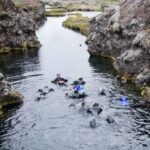 Silfra is a fissure in Thingvellir, cutting into the Thingvalla lake (Þingvallavatn) and immersed in its icy waters. The water is amazingly clear and the chance to dive (or snorkel) in the space between Europe and North America is definitely tempting.
Silfra is a fissure in Thingvellir, cutting into the Thingvalla lake (Þingvallavatn) and immersed in its icy waters. The water is amazingly clear and the chance to dive (or snorkel) in the space between Europe and North America is definitely tempting.
The water in Silfra fissure is in near-freezing temperature, so using a dry suit is highly recommended. But if you’re not a dry suit certified diver, you can still go for a dry suit snorkeling tour (no experience required, but you have to be at least a little fit). Here are your basic options:
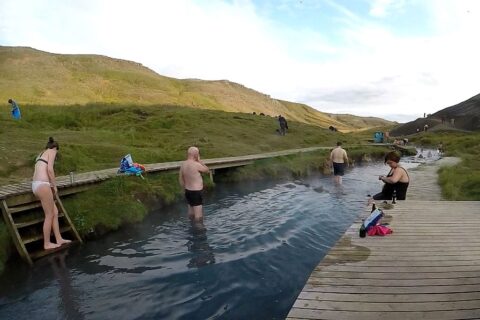 Reykjadalur literally means “Steamy Valley”. A stream that flows in the middle of this high mountain valley offers something unimaginable and absolutely unmatched: a warm, even a hot bath!
Reykjadalur literally means “Steamy Valley”. A stream that flows in the middle of this high mountain valley offers something unimaginable and absolutely unmatched: a warm, even a hot bath!
Unlike most attractions on this list, Reykjadalur requires about 45 minutes of walking from the parking lot below the valley but the view and the experience are totally worth the effort. This place is truly unique, so read more about it here: Reykjadalur – Hot Bath in a Mountain Stream.
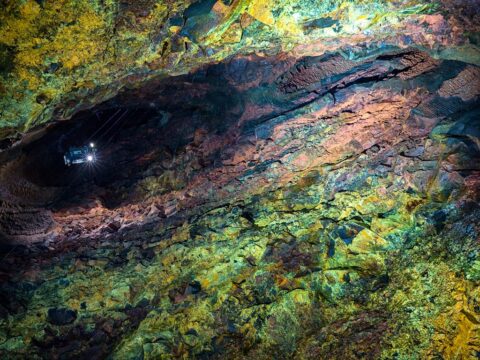 Looking for extreme thrills? Go straight into the magma chamber of a dormant volcano. Admiring the inside of a volcanic crater, with its walls in unbelievable colors and textures will be something to remember for years and years.
Looking for extreme thrills? Go straight into the magma chamber of a dormant volcano. Admiring the inside of a volcanic crater, with its walls in unbelievable colors and textures will be something to remember for years and years.
This trip is both time-consuming and expensive but it is the only place of this kind in the world so if you have the time and means – go for it.
Thrihnukagigur tour is rather expensive and very rarely included in any general Golden Circle tours. If you want to visit it, you have to book a tour separately here: Inside the Volcano. It’s a 6-hour experience with a bit of hiking necessary. The price is $425 pp and the minimum age: 12.
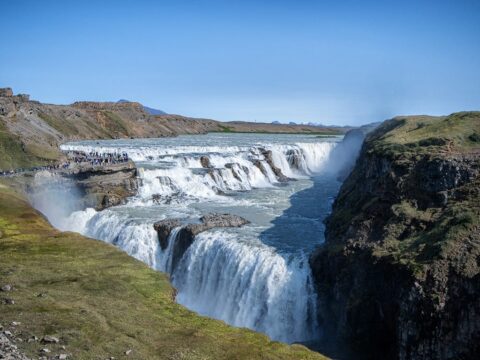 Gullfoss undoubtedly is one of those Icelandic waterfalls you just have to see with your own eyes. It is characteristically wide, with powerful cascades of water tumbling over vertical precipices.
Gullfoss undoubtedly is one of those Icelandic waterfalls you just have to see with your own eyes. It is characteristically wide, with powerful cascades of water tumbling over vertical precipices.
The roar of all this water falling can easily drown out any normal conversation, and when the wind blows from the waterfall, your chances of remaining dry are close to zero. You can really experience the power of nature here.
More: Gullfoss – a Waterfall Full of Gold.
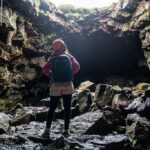 Raufarholshellir is a cave that is available for visitors. In fact, like many other ones, it is an empty lava tube. It is estimated to be as old as 5 thousand years and it was formed as a result of a volcanic eruption nearby. Inside you can see various rock formations and reddish traces of solidified lava on the walls. In winter freezing water creates stalagmites and stalactites that look like glass sculptures.
Raufarholshellir is a cave that is available for visitors. In fact, like many other ones, it is an empty lava tube. It is estimated to be as old as 5 thousand years and it was formed as a result of a volcanic eruption nearby. Inside you can see various rock formations and reddish traces of solidified lava on the walls. In winter freezing water creates stalagmites and stalactites that look like glass sculptures.
If you want to visit this cave, the best option is to book a 3-hour tour from Reykjavik: The Lava Tunnel ($115 pp) or if you can drive up to it, you can purchase the ‘no pick-up’ version, where you arrive at location by yourself: The Lava Tunnel self-drive ($70 pp).
Opened on October 15, 2025 it is very conveniently located almost exactly in the middle between two other major attractions – Gullfoss waterfall and Kerid crater. It is also just a few kilometers away from the Fridheimar restaurant. It’s really easy to add it to your itinerary either in the middle or by the end of your Golden Circle day.
Laugaras lagoon actually has two lagoons, one located slightly higher up than the other. There’s also a hot pool, a quiet corner, saunas, bars, a beautiful view and a quality restaurant. Maybe there’s nothing really extraordinary here (unless the waterfall between lagoons is supposed to play that role), but the quality of the place, variety of the pools and the entry price are all very well balanced.
It is also a lot more quiet and tranquil then many other pools in Iceland, because it’s not large and kids under 8 are not allowed. If you’re travelling with your family – you might be out of luck – but if you’re looking for a quiet place to immerse yourself in soothing waters – this is definitely your #1 place in the Golden Circle for that.
You can book your tickets here: Lerki – Premium entry or read more about Laugaras Lagoon in our dedicated article: Laugaras Lagoon – the Newest Pools on the Golden Circle.
It’s really small and set in a picturesque landscape. If you’re lucky to be there on your own – it’s a perfect place to enjoy a hot pool in nature.
As of 2024 Hrunalaug is not so “wild” and uncivilised as it used to be. There’s proper changing rooms (or huts?), small ticket office building (charging 2500 ISK pp / $20) and limits on how many people can get in simultaneously.
The place retains its original, somewhat wild character, but is now a little more tidy and organized.
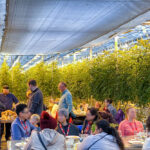 Fridheimar is a special place on the culinary map of Iceland. It attracts not only foodies and those looking for adventures on their plates.
Fridheimar is a special place on the culinary map of Iceland. It attracts not only foodies and those looking for adventures on their plates.
This restaurant works inside a greenhouse complex that uses geothermal methods to grow amazing, local and 100% organic tomatoes. The design is unusual, as is the vibe of this place that serves fresh and light meals made with natural ingredients. If you are planning to visit restaurants on the Golden Circle, this should be your absolute priority.
Fridheimar restaurant – an unusual place for tomato lovers
Another place that merits a mention is the Ingólfsskáli Viking Restaurant where you can not only try traditional Icelandic dishes but also play traditional sports, like axe throwing (berserkir axarkast).
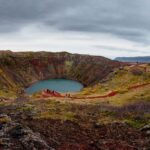 Every Golden Circle tour needs to include a volcano. And Kerid is certainly among the prettiest in the whole of Iceland.
Every Golden Circle tour needs to include a volcano. And Kerid is certainly among the prettiest in the whole of Iceland.
It’s a beautiful and well preserved crater with a picturesque lake at the bottom. The walls surrounding the lake are covered in red dust, which, given the light is good, creates an even more appealing and special visual effect. It’s gotten a bit expensive recently and so not all Golden Circle tours include it, but it’s definitely worth a stop, especially if you’re not planning on visiting Iceland’s interior, and the even more magnificent Ljotipollur crater.
Obviously Iceland is full of volcanos, and many of the old craters do hold a similar lake inside them. The absolute #1 to visit is Viti in Askja range. The amazing thing about this one is that it’s water is warm and… yes, you can swim in it!.
A crater lake similar to Kerid is also the Viti in Krafla, in the Myvatn lake area, in the North. A very nice place to stop if you’re going around Iceland.
Other similar craters, albeit without lakes, include Grabrok and Saxholl. Additionally, Hverfjall in the Myvatn area is worth mentioning here, although it is a bit of a different type of volcano cone, as it’s not made of lava…
See our special Top 10 list of interesting volcanoes in Iceland: Top 10 Iceland’s Volcanoes.
For those who are up for even bigger thrills or simply have more time to go slightly off the main road, here are top 3 activities in the vicinity of Reykjavik, but outside of what is defined as the Golden Circle:
Read more: Glymur – Iceland’s Highest Tourist Waterfall.
Trekking in the Botndalur valley to admire this waterfall is not tough, but there are some obstacles along the way and the hike is about 5 km uphill. To be practical, make a plan to spend at least half a day on this trip. The views on the hike and at the end of it are more than worth the effort.
As of 2021 the area north of Grindavik has become volcanically active (again) and brings a new eruption once or twice a year. These eruptions are quite mild in nature, usually come down to a rather calm outflow of lava, and often can be viewed from a relatively short distance. They are expected to remain active for decades to come.
Read more about Grindavik and the surrounding area here Grindavik Surroundings – Top Things to See in the Reykjanes Peninsula.
Read the article about this volcano: its history and how to best visit it today: Hekla – the Queen of Iceland’s Volcanoes.
Check out other articles about exciting places in the vicinity of Hekla: Hekla region
Iceland is a country of extremes, where two greatest opposites – fire and ice – live lovingly intertwined. This union creates unparalleled landscapes that will leave no one indifferent.
Many of these interesting places are near Reykjavik and on the so-called Golden Circle. Some are even on the list of “Iceland’s Top 10” but all of them are worth seeing at the start – or at the end – of your journey through this amazing island. Additionally, it is great that many of the attractions on the Golden Circle are situated close to major roads so you can reach them in all seasons. If you travel to Iceland in winter, the Golden Circle is potentially the most accessible cluster of tourist attractions.
Obviously, if you only have 2-3 days in Iceland, the only practical alternative to the Golden Circle will be the Snaefellsnes peninsula. Bit it is more of an addition to the Golden Circle than a realistic alternative. Read about Snaefellsnes here: Top places in Snaefellsnes
There is no way to name all the possible attractions in Iceland, not even in one region. The list above is to make sure you are not bored and have good ideas for things to see. If you are planning to spend more time on the island, consider expanding beyond the Golden Circle, to the south-west, up to the black beach in Vik. Find out more about this region and its attractions Southern Iceland.